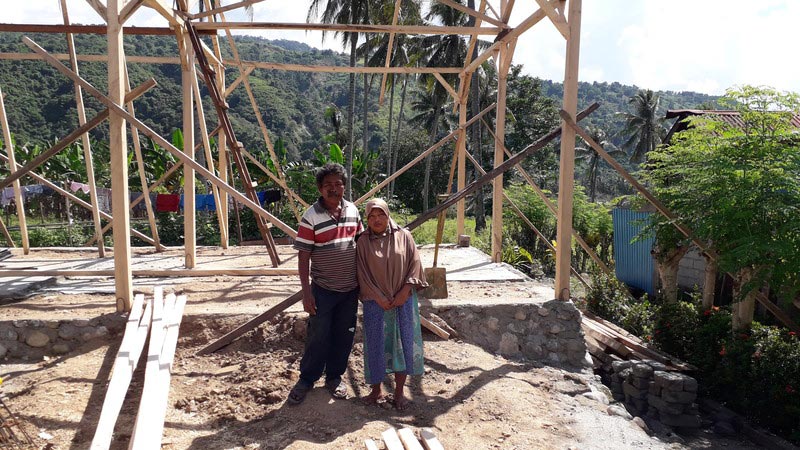Indonesia earthquake and tsunami: Residents remain positive 12 months on

Yael Eshel is CAFOD’s Emergency Response Officer for Indonesia. Here she shares stories from a recent visit to Indonesia’s Central Sulawesi province, where she met families affected by the devastating earthquake and tsunami in 2018, and found out how they are rebuilding their lives thanks to donations from CAFOD supporters.
Earthquake debris and partially collapsed buildings are strewn across the Indonesian city of Palu and nearby coastline. A mosque stands partially submerged in the sea – giving the impression it is floating on water.
It acts as a constant reminder and informal memorial to last year’s tsunami and earthquake, which claimed the lives of thousands of people and destroyed homes and infrastructure in Indonesia’s Central Sulawesi province.
I am visiting Palu for the first time since the disaster. Standing on the shore near to the mosque I am joined by women, men and groups of families, many of whom visit this spot every day to remember lost loved ones.
As I walk around Palu I see hundreds of partially destroyed homes that have had to be abandoned by their owners. On them, graffiti writings ask people to remember the date of the disaster – 28 September 2018.
Since the earthquake and tsunami hit, CAFOD has been working with local aid experts to provide much needed emergency relief, and to support people to rebuild homes and local businesses, as well as better prepare for any future emergencies.
Ground flowed like water
One of the most horrifying aspects of this disaster was a natural phenomenon called ‘soil liquefaction’ – something not previously known to or experienced by people in the region.
Soil liquefaction is when pressure created by an earthquake causes soil to behave like liquid – prompting people and their homes to flow like water and be literally sucked into the earth.
A year on and hundreds of people remain ‘missing’, most likely buried under layers of debris in several ‘liquefaction sites’ across the region. These sites have been clearly marked by the local government as no-build ‘red zones’, which means no one will ever be allowed to build there in the future.
Visiting one of the sites is a surreal experience – it is impossible to comprehend the fear residents must have felt as the floor of their homes began to slide, and walls collapsed around them.
The sites are silent testimonies of what happened to the people who lived there – they remain untouched from the moment they eventually stopped moving, and it is shocking to witness the debris of partially collapsed homes and mountains of personal items.
Families remain positive
Despite the devastation, I met incredibly resilient people who remain hopeful for what the future may bring.
26-year-old Sri Yanti survived, but her home was destroyed by soil liquefaction. She is living with her husband and 9-year-old child in a temporary camp in Sigi District, one of the worst affected regions.
Conditions are extremely difficult. There are only a few communal toilets, space is tight, and her tent provides little shelter from the sun and heat. Yet, Sri Yanti is managing to remain positive and is looking forward to moving into a new home being built nearby.
I also heard stories of strength and community solidarity – friends and family coming together to support those who were left homeless and lost all their belongings in the disaster.
Reaching the most remote villages
In a quiet valley away from the coast, the picturesque village of Salua was devastated by the earthquake. These remote areas were much harder to reach after the earthquake as dirt roads were impassable.
Even now it is difficult for CAFOD’s local aid workers to reach these communities – floods frequently submerge the road and often the only access is via motorcycle. When I made the journey, we were forced to overcome obstacles along the route, negotiating the winding roads and muddy terrain.
Families in Salua proudly welcomed me into their new homes. They have been built just months after the earthquake thanks to donations from CAFOD supporters, who once again showed enormous generosity by raising more than £500,000 for people affected by this disaster.
In the immediate aftermath this was used to provide emergency food, aid and clean water, and since then has gone towards rebuilding homes and repairing water pipes and toilets.
We have also provided training for 1,000 community members, allowing them to become emergency experts and create community action plans – meaning thousands more people will be equipped if another disaster hits.
I met with inspiring women like Darlin, 33, who is a key figure in the Salua community. When the earthquake destroyed the homes of Darlin’s friends and family, she gave them nearby land that she owned so they could rebuild their homes.
Sharing land for the common good
In Indonesia it is not unusual for women to own land, and ownership of land is seen differently to most other places in the world. Amazingly, when a community needs land to rebuild after a disaster, people will always come forward to help.
Darlin also uses her newly built home as a place to sell hot meals, and we sit together with a few other family members to enjoy sweet coffee and peanut biscuits she baked for the recent Eid celebration.
The resilience and positivity of people like Darlin astounded me. In such a short period of time since the terrible emergency, Indonesians are rebuilding their lives and looking ahead to the future.
This article was originally published in the Catholic Times newspaper.